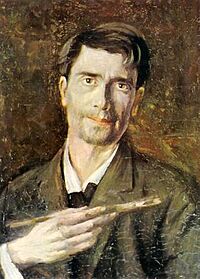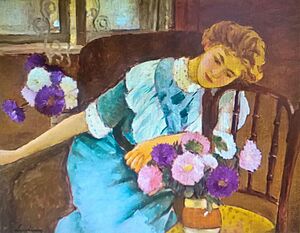Ștefan Luchian facts for kids
Quick facts for kids
Ștefan Luchian
|
|
|---|---|

A Housepainter (self-portrait), 1909
|
|
| Born | 1 February 1868 Ștefănești, Botoșani County, Romania
|
| Died | 28 June 1916 (aged 48) |
| Resting place | Bellu Cemetery, Bucharest |
| Nationality | Romanian |
| Alma mater | National School of Fine Arts |
| Known for | Painting, and modernism |
| Movement | Impressionism, Post-impressionism, Symbolism |
| Patron(s) | Alexandru Bogdan-Pitești Take Ionescu |
Ștefan Luchian (born February 1, 1868 – died June 28, 1916) was a famous Romanian painter. He is well-known for his beautiful landscapes and still life paintings, especially his flowers.
Contents
The Life of Ștefan Luchian
Early Years and Art School
Ștefan Luchian was born in Ștefănești, a village in Botoșani County, Romania. His father was Major Dumitru Luchian. In 1873, his family moved to Bucharest.
Ștefan's mother wanted him to join the Military School, like his father. But Ștefan had other plans. In 1885, he joined the painting class at the Fine Arts School. There, a famous artist named Nicolae Grigorescu encouraged him to become an artist. Grigorescu's work greatly influenced Luchian throughout his life.
In the autumn of 1889, Luchian studied for two semesters in Munich. He attended the Fine Arts Academy. While there, he made copies of paintings by famous artists like Correggio and Rembrandt. These copies were kept in the Kunstareal museum.
After returning to Romania, Luchian took part in his first art show. This was with an art group called Cercul Artistic. He found it hard to accept the old-fashioned rules of art schools. So, the next year, he went to Paris. He studied at the Académie Julian. Even though his teacher was a traditional artist, Luchian discovered Impressionist art.
Luchian's painting Ultima cursă de toamnă shows the influence of artists like Édouard Manet and Edgar Degas. He was also inspired by new art movements like Modernism and Post-impressionism. These influences can be seen in his works even after he returned to Bucharest.
Health Challenges and Later Works
In 1896, Luchian helped start a new art group in Bucharest. It was called Salonul Independenților. This group was created as an alternative to the official art show. Two years later, this group led to the creation of Societatea Ileana. Luchian was the first artist to create illustrations for their magazine, Ileana.
Around this time, Luchian started adding Symbolist elements to his art. He was inspired by styles like Art Nouveau and Mir iskusstva.
In 1900, Luchian showed two pastel paintings at the World Fair in Paris. In the same year, he started feeling the first signs of multiple sclerosis. This illness affected him for the rest of his life. Even with his health problems, he kept painting. He showed his works in many exhibitions until 1915. However, most people were not very interested in his art at first.
At his 1905 exhibition, his former teacher, Grigorescu, was the only person to buy a painting. Although some people, like the writer Ion Luca Caragiale, admired his work, Luchian lived in poverty. He had inherited a lot of money, but it slowly ran out.
From 1909, Luchian became paralysed. He had to spend the rest of his life in an armchair. But this did not stop him from creating many landscapes and flower paintings. He had started painting flowers earlier, but after 1908, he focused all his energy on them. Towards the end of his life, Luchian could no longer hold a brush with his fingers. People had to help tie the brush to his wrist so he could keep painting.
Around this time, his art started to become more popular. The writer Tudor Arghezi believed this was partly because a politician named Take Ionescu became very famous. Ionescu was one of the first people to buy several of Luchian's paintings. As Luchian's illness became well-known, a false rumor spread. It was said that someone else was painting in his name. This led to Luchian's brief arrest, but he was released soon after. Arghezi was proud to be one of the few people who defended him.
One of the last special moments in Luchian's life was a visit from the famous composer and violinist George Enescu. They had never met before. Enescu played his violin as a personal tribute to the dying artist.
Ștefan Luchian died in Bucharest and was buried at the city's Bellu Cemetery.
Luchian's Artistic Legacy
By the 1930s, people started debating Luchian's importance in Romanian art. Some critics claimed his work was not very important. They also said that stories about his life were exaggerated. Arghezi, the writer, again stepped in to defend Luchian. He wrote passionate articles supporting Luchian's art. He believed that negative reactions came from jealousy and from Luchian's dislike of average art.
In 1948, after his death, Luchian was chosen to be a member of the Romanian Academy. An art school in Botoșani is named after him.
Luchian's life was also made into a film in 1981. It was directed by Nicolae Mărgineanu and called Ștefan Luchian. The actor Ion Caramitru played Luchian.
Gallery
See also
 In Spanish: Ștefan Luchian para niños
In Spanish: Ștefan Luchian para niños















